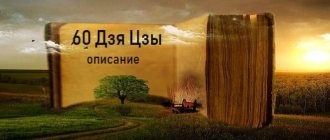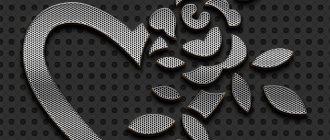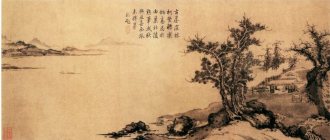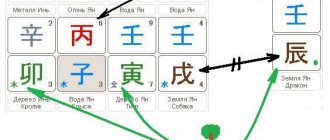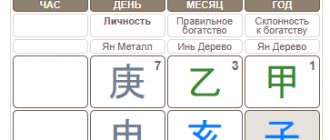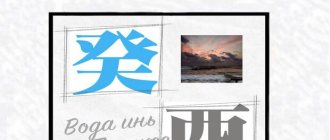4.8
(48)
“Whatever is below is like what is above” - astrological aphorism
According to astrology, the Universe is filled with 5 elements (Latin elementum - primary matter, element, origin). The lower four elements (elements) are located in the Sublunar World, that is, between the planets Earth and the Moon in the following sequence:
- Earth
- Water
- Air
- Fire
The “heavier” an element, the closer it is to planet Earth, where coarse matter predominates. And vice versa, the “lighter” the element, the closer it is to the Moon. In addition to the four subtle material elements in the Universe, there is also a subtle 5th element, which is called quintessence (from the Latin quinta essentia - fifth being). The fifth element is Ether .
Elements in astrology
To begin with, it should be noted that elements in astrology and elements in chemistry are different concepts. Therefore, in Russian, astrological elements are often called elements.
In astrological science, each of the four sublunar elements (elements) represents one of the states of the single First Matter - a combination of basic qualities - heat, cold, moisture and dryness.
The two passive or feminine elements represent cold. This is Earth and Water. The two active or masculine elements represent heat. These are Air and Fire. Dryness is represented by the elements Earth and Fire. Humidity - Water and Air. Thus, each of the sublunar elements represents two states of the First Matter:
- Earth - cold and dry;
- Water - cold and wet;
- Air - heat and humidity;
- Fire is warm and dry.
In astrology, the four elements have the following characteristics:
Earth - thoroughness, firmness in one’s rightness, steadfastness in one’s decision, the desire to collect and accumulate; Water - emotionality, receptivity, touchiness, ability to understand others, intuitive thinking; Air - lightness, curiosity, sociability, the ability to negotiate and conduct dialogue, the desire to know everything; Fire - uncontrollability, swiftness, belligerence, the desire to win, intransigence, the desire to command.
For more information about the characteristics of the four elements according to the signs of the Zodiac, read the article Astrological signs of the Zodiac.
The four sublunar elements in astrology are usually designated by the following symbols.
Symbols of the four sublunar elements.
Why were different types of triangles chosen to represent the lower elements? The following illustration will help the reader understand where these triangles come from and how they are related to the symbol of quintessence, that is, the 5th superlunar element - Ether.
Características principales
Chinese philosophy reveals the relationship between them from different sides: according to the path passed down from generation to generation, each element gives rise to another, completing a harmonious cycle between the five elements.
Another perspective is the cycle of dominance, also known as the star of destruction. In this method, each element is sent to another element until the loop is restarted.
To fully understand the 5 elements of nature, we must have a good understanding of what an ecosystem is. An ecosystem is a system, that is, a set of interacting elements, which include: the physical environment, organisms and their interactions (predator, predator, parasite-host, competition, symbiosis, pollination, distribution of insects). Seeds, etc.).
When people view an ecosystem as part of the natural world, the distance between the appropriate definition and the greater distance is determined by the types of organisms that coexist and their interactions. This is an object of environmental research. Environmentalists set their limits based on their work needs. An ecosystem can be the stomach of ruminants, their intestinal flora, ponds, forests, lakes. It consists of dynamically related biological (biological pollution) and non-biological (biological communities) elements. That is, it is a functional unit in which living and nonliving elements of the environment are integrated in a complex way.
Ether - the fifth element
Ether (from the other Greek word αἰθήρ - transparent, clear sky; and from the Latin word aether - celestial beings) is the 5th element in ancient and medieval philosophy, physics and alchemy. It is with ether that the space of the Universe is filled, starting from the first sphere of the Universe - the sky of the Moon. Figuratively speaking, in the entire Sublunary world, no one located below the Moon can “breathe” the ether - the “air” of the gods. Therefore, there is no immortality in the Sublunary World. The popular expression goes like this: Nothing lasts forever under the Moon.
Ancient sages allegorically said that immortal gods “breathe” ether, in contrast to mortal people who breathe only air. Ether was called not only the quintessence, but also the “elixir of immortality.” Therefore, from the word “ether/ether” in some languages words with the meaning “eternity” were derived:
- aeternum - in Latin;
- eternità - in Italian;
- éternité - in French;
- eternidad - in Spanish;
- eternity - in English.
Above in the article the characteristics of the four sublunar elements were given. If each of these elements has only two states of Primary Matter, then Ether, the fifth supralunar element, is not limited by this. And if each of the lower elements can be either male or female, then the highest element combines two principles of the Universe - Yin-Yang , because the Ether is higher than the divided states of the Sublunary World.
In J. Cooper's encyclopedia of symbols about Yin-Yang symbolism we read the following:
Yin represents the feminine principle. Yang symbolizes the masculine principle. Together they symbolize all the complementary opposites of the dualistic Universe. The same applies to the lotus. The Yin-Yang symbol (da ji) represents the perfect balance of the two great forces of the Universe, each of which has within itself an embryo of the opposite principle.
This suggests that in the Universe there is no only male or only female principle. This is the Cosmic Egg; the original Androgyne, reflecting the perfection of balance and harmony; pure essence is the union of two principles. These two forces hold each other in opposition, but not in an antagonistic way, but as interdependent partners.
Thus, the 5th element can be given the following characteristics:
Ether is the unity of opposites, balance, harmony, integrity, completeness, perfection, androgyny.
Symbols of balance, integrity, completeness and unity.
Characteristics of the Five Elements
The five elements (Fire, Water, Metal, Wood, Earth) represent energy flows of appropriate quality. The theory of the origin, interaction and influence of these elements has been studied in detail in Chinese philosophy. Elements constantly flow from one state to another, accelerating or slowing down, circulating and changing the qualities of the environment. The primary elements are not dense matter, but a dynamic, continuous flow of energy of different properties:
- Fire represents summer and heat.
- Tree – spring and the awakening of nature.
- Earth – balance and maturation, changing seasons.
- Metal – withering and autumn.
- Water - hibernation.
Tree
Among the main elements, the element of Wood most influences the development and growth of abilities. The characteristics of this element are as follows:
- direction – east (family) and southeast (wealth zone);
- Green colour;
- geometric figure - rectangles, rhombuses (oblong and tall shapes);
- material – wooden and wicker furniture, plants and paper products;
- season – spring;
- time of day - morning;
- number – 3 and 4;
- the taste is sour.
Water
All 5 elements of nature come from the first element – Water. This element is a conductor of energy, symbolizes wealth, and has a cleansing and renewing effect. Characteristics of Water include:
- direction – north (career);
- color – blue and black colors;
- geometric figure - wavy and winding pattern;
- material – water, aquariums, fountains, glass, mirror;
- season – winter;
- time of day – night;
- number – 1;
- taste – salty.
Metal
Metal ensures success in financial matters and brings abundance. The influence of Metal elements in the interior gives clarity of thinking and develops attention. The nature of this element:
- direction – northwest (travel);
- color - white, gray, silver, gold and bronze shades;
- geometric figure - circle, oval, crescent;
- material – metal products, electrical appliances, weapons;
- season – autumn;
- time of day - evening;
- number – 6 and 7;
- the taste is spicy.
Fire
The formula of the five elements would not be complete without the symbol of Fire. This element symbolizes success in society, recognition and glory. Its characteristics:
- direction – south (glory zone);
- color – red and orange shades;
- geometric figure - triangles and acute angles;
- material – candles, lamps, fireplaces, images of the sun and fire;
- season – summer;
- time of day – noon;
- number – 9;
- the taste is bitter.
Earth
Earth energies bring confidence and stability. The characteristics of this element are as follows:
- direction – center (luck), southwest (marriage and sex), northeast (knowledge);
- color – yellow and brown shades;
- geometric figure - cube, square;
- material – crystals, clay, marble, ceramic and faience products;
- season – the last month of each season;
- time of day – day;
- number – 2, 5, 8;
- the taste is sweet.
Correspondences to the 5 elements in religions
The number 5, being a symbol of the 5 elements of the Universe, is considered sacred in the religions of the world. The creators of religious cults were well aware of what lay behind this number.
The Hindu deity named Shiva has 5 faces, and his mantra is called Panchakshari, that is, the “Five Words” mantra. The Hindu goddess Saraswati, the goddess of knowledge and wisdom, is also associated with Panchami, or the number 5. The most sacred tree in Hinduism has 5 leaves on each leaf.
The Hindu god Shiva has five faces. The Torah, the sacred Scripture of Judaism, contains 5 books - Genesis, Exodus, Leviticus, Numbers and Deuteronomy, which are collectively called the Pentateuch. The Biblical Book of Psalms also consists of 5 books, in accordance with the Pentateuch.
In front of the entrance to the Tabernacle described in the Pentateuch, there were 5 pillars on the east side of the courtyard. Read about the structure of the Tabernacle and its astral symbolism in the article The Biblical Tabernacle - the image of the Universe.
The Torah consists of five books - the Pentateuch.
Five pillars in front of the entrance to the Tabernacle. Muslims have 5 pillars of Islam - the main regulations of Sharia, which form the basis of Islam and are mandatory for all Muslims. The Muslim religion is based on 5 main religious duties, formulated during the life of the Prophet Muhammad:
- declaration of faith (shahadah) - Ether ;
- five daily prayers (namaz) - Fire ;
- fasting during the month of Ramadan (Eid) - Air ;
- tax for the benefit of the needy (zakat) - Water ;
- pilgrimage to Mecca (Hajj) - Earth .
Every adult Muslim is required to perform prayer (namaz) 5 times a day. Prayer is performed at a certain time, in accordance with the established ritual:
- morning prayer (fajr) - Water ;
- midday prayer (zuhr) - Fire ;
- evening prayer (asr) - Air ;
- evening prayer (Maghrib) - Earth ;
- night prayer (isha) - Ether .
Catholics have rosaries and a special prayer for them is called the Rosary.
This prayer is associated with reflection on the three Fives, the Five Joyful, the Five Sorrowful and the Five Sacraments of the Virgin Mary, whose attribute is the rose, and in the countries of the East - the lotus. The epithet Dea Maris (Latin: Goddess of the Sea), from whom the Christian Virgin Mary originated, was the name given to the lunar goddess Isis (Latin: Isis) in the ancient world. Rosalia, or Rosary (from the Latin Rosalia, Rosaria, Dies rosae) is a rose festival, which takes place in ancient Rome in mid-May during the flowering of roses. The rose symbolizes the number 5, the five main phases of the Moon, as well as the quintessence, that is, the 5th element - Ether .
Orthodox churches often have 5 domes. In the middle of the four there is one large dome. It's not hard to guess why. The four smaller domes symbolize the four lower (sublunar) elements, and the central large one symbolizes the higher (supralunar) element - Ether.
Five domes symbolizing the 5 elements (elements).
Read what the 7 domes on Orthodox churches symbolize in the article Seven planets in astrology and their earthly correspondences.
Hamsa (Arabic خمسة, Hebrew חמסה: five) is a protective amulet in the shape of an open palm with 5 fingers in the countries of the Middle East and Maghreb. Muslims call this symbol the Hand of Fatima, and Jews call it the Hand of Miriam. Hamsa was used as a protective amulet even before its use by adherents of monotheistic religions. For example, in Ancient Egypt this amulet was called the Hand of Isis.
An open palm with 5 fingers is also found in Mesopotamian amulets called the Hand of Inanna (Ishtar, Astarte), the Mano Pantea amulet (Hand of All Goddesses), the Buddha's mudra of teaching and protection - Dharmachakra mudra.
As a rule, anchovy is symmetrical, with thumbs on both sides, and does not copy the anatomical shape of the palm. The Muslim hamsa contains the image of an eye, and the Jewish one contains a hexagram or Hebrew letter - ה (he).
Samples of anchovy - a protective amulet in the countries of the Middle East and Maghreb.
And here is a photo of a kind of “anchovy” from the wall of a Roman Catholic church. As you can see, on the top of the church wall there is not only a palm with 5 fingers, but also a foot with 5 fingers. And even the head of some deity. Obviously, all three amulets should bring good luck and happiness to the parishioners of this Polish church...
The wall of the Catholic Church in Drohobych, Lviv region, Galicia.
Wu-shin theory of 5 primary elements. Tree. Fire. Earth. Metal. Water
By observing the cycles of life, the course of stars and weather changes, people studied natural phenomena and connected them with human life.
It was from these observations that the doctrine of Tao was born. Tao means "that which cannot be named." It has no direction, no will, no goal, but everything is born from it. From Tao arose the opposites Yin and Yang, earth and sky, matter and energy. And from these, in turn, the Five Elements (Elements) were born - Fire, Earth, Metal, Water, Wood.
The Chinese term "disaster" does not have the same meaning as the Western one. The Chinese define an element not as a material substance, but rather as a force - a special property of the Universe. This term refers generally to the laws of nature and its basic principles. The elements are regarded as transitional phases of various manifestations of Qi, as energy states that repeat themselves again and again.
According to Chinese views, the Five Elements are manifested in all phenomena of our world, our Universe: space and time, stars, climate, seasons, the existence of plants and animals, and, finally, in human lives. The organs and tissues of living beings, as well as their perceptions, sensations, emotions and mental capabilities are closely related to the elements. The elements maintain balance in each other, give birth to each other, pass over and control one another.
If the energy levels of the elements are not balanced, then people experience discomfort and illness, and in society - unrest, revolutions, and wars. When the elements are balanced and strong, a person gains health, and the world gains harmony, beauty and mercy.
Wood element
The tree brings the desire for movement and growth. It stimulates creative processes - planning and decision-making, conveys a desire for new horizons, projects and discoveries. The color green is associated with Tree.
The tree symbolizes growth in all directions: up and down, west and east, north and south. A tree is a symbol of powerful energy. In autumn and winter, it withdraws into itself and accumulates strength for the next spring and summer, for a new growth cycle.
The organs of the Tree are the liver and gall bladder.
The liver contains the energy of the Yin Wood.
It is the Liver that creates the power of imagination, the energy of creation, which is expressed in growth. The liver is an inventor, a discoverer, an innovator.
The Yang organ of the Wood element is the Gall Bladder .
It is responsible for our ability to make decisions and assert our needs in the real world. The Liver can be compared to an architect who designs a house, and the Gallbladder is like a builder who makes the decisions necessary to make the house a reality. The functions of both organs are closely related. Without a common, overarching idea, decisions made day after day are incoherent and meaningless. At the same time, grandiose plans are worthless if they are not implemented.
To implement any project you need to take certain steps. We must overcome ourselves and bring to life what we need. Therefore, muscles and tendons also belong to the element of Wood.
Tree growth occurs in all directions. If there is enough space and nutrition, the tree grows symmetrical. Coordination and symmetry are the basic characteristics of this element in nature and in human life. The causes of many diseases, the symptoms of which appear in only one half of the body, or diseases characterized by insufficient coordination in the functioning of the organs, can be found in disturbances of the element of Wood. Very often, an imbalance in the Wood element can be determined by the asymmetry of the face or body, or by a significant difference in visual acuity of the eyes.
The main role of the Tree is to restore mental, spiritual and physical balance, the coordinated work of the right and left hemispheres of the brain.
Spring is the time of awakening of the powers of the Tree.
When the element of Wood is in balance, the coming spring brings new interests and goals, new energy. And, conversely, if the element of Wood is “exhausted,” fatigue and depression come along with spring.
If you can preserve the vital energy received in the spring, carry it through the summer heat, the period of fruit ripening in late summer, the autumn harvest and winter dormancy, then seeds will sprout, ready for a new cycle of development.
Element Fire
If the nature of Wood is expansion and growth in all directions, then the power of Fire strives vertically upward, from the depths of the earth to the sky, from the material to the spiritual, from ignorance to knowledge. Its colors are scarlet and red.
The Yin organ belonging to the element of Fire is the Heart . He is also called the Fire Prince, the supreme ruler of all organs. The heart is the center of consciousness, feelings and thoughts.
When the Fire energy located in the heart is too active, the Chinese say it is an excess of Qi. The consequence of this excess is talkativeness, profuse sweating and nervous tension. People in this state believe that they must take everything into their own hands, must control everything themselves. Most often, they are unable to allow others to take responsibility for themselves. This is typical of the modern "manager's disease", which often leads to heart disease. This imbalance usually occurs as a result of a deficiency in the energy of the Water element.
The lack of Fire energy in the heart is called Xiu - “incomplete”, “imperfect”. Xiu leads to such disorders as the inability to clearly express one’s thoughts, muteness, and perversion of taste. Since the Heart is responsible for “internal content,” its functions include purification of thoughts and speech, as well as the formation of responsibility and motivation.
Activation of the Heart meridian is usually used to treat neurological disorders: insomnia, nervousness, hysteria, manic-depressive psychosis, epilepsy. And also to correct speech disorders or to learn to listen to other people.
The Small Intestine is the first Yang organ associated with the Heart. The function of the Small Intestine is to absorb nutrients during the digestive process. The small intestine allows nutrients to be absorbed into the blood. It also influences a person’s intellectual level through receptivity to ideas.
A deficiency of energy in the Small Intestine manifests itself in a person if he accepts the knowledge, beliefs, beliefs of other people without processing, that is, without “digesting” them. Such a person is not able to develop his own system of ideas and beliefs.
When the element of Fire in the human body is balanced, summer brings him joy and the fulfillment of all desires. Such people are calm and balanced. They are able to foresee future events. They know when to speak and when to remain silent. The joy they experience is never excessive. They may be leaders, but they always know when to step aside. Their eyes radiate light and joy. They are familiar with kindness and generosity. They have good taste.
Element Earth
The middle is the direction corresponding to the Earth, it is not Yin or Yang. The Earth's energy moves horizontally in a vicious circle. Transitional periods between seasons are also associated with the elements of the Earth. These are moments when you need to look inside yourself and gather strength for a new phase of life.
The colors of the Earth are yellow and brown.
In humans, the element of the Earth manifests itself through compassion, understanding, empathy and love, unity with nature and other people. Such a worldview provides a person with the desired reception everywhere. He is at home everywhere, and he is always welcome. A person with a healthy Earth element has an inner wealth that allows him to give and care for others.
The spleen is the Yin organ of the Earth element . She is characterized by logical thinking, a rational mind, the ability to criticize, the ability to think everything through and a good memory.
The opposite characteristics are worrying about a thousand little things, returning to the past and addiction to fruitless memories.
On an intellectual level, the action of the spirit of the Earth is seen in the categories and concepts that we use to describe late summer: gathering, processing, selection, nutrition, survival and gaining the wisdom that brings a sense of security in the various situations in which life puts us.
A person with a developed Earth spirit reads a lot, thinks, collects information, stores and processes it. True, the latter is only possible when a person has enough Fire: independence, the ability to choose and process the collected facts.
The state of Shi, or Fullness of the Spleen, is characterized by non-stop thinking: an incessant internal monologue.
On a physical level, the spleen regulates the distribution of water and blood.
In addition to the Spleen, the elements of the Earth include connective, fatty and muscle tissue. And also the Yang organ - Stomach . The stomach in Chinese tradition is considered to be the combination of the lips, oral cavity, esophagus, stomach, duodenum and the initial part of the small intestine. That is, the stomach is the system responsible for the absorption of nutrients.
The main function of the Earth's organs is to nourish and maintain the constancy of the internal environment of the body. After all, the Chinese concept of “nutrition” refers not only to providing the body’s cells with nutrients, but also to supplying them with oxygen.
Disturbances in the rhythm of life also indicate an imbalance in the elements of the Earth.
Rhythms of sleep and wakefulness, breathing rhythm, menstrual cycle, diet, rhythms of physical, spiritual and psychological activity - all of them are to a certain extent related to the rotation of the Earth around its axis and around the Sun.
The earth generally plays a central role in the Chinese worldview. In the earliest diagrams of the Five Elements, Earth is depicted in the center, with the elements of Water, Wood, Fire and Metal surrounding it on four sides. In ancient China, there were medical schools in which all physical and mental disorders were treated by restoring the balance of the elements of the Earth.
In these schools, results were achieved through practical knowledge of the power of the elements in various foods and medicinal herbs, as well as through the use of massage and acupuncture of the Stomach and Spleen meridians. Special physical exercises were also used to enhance the energy of the Earth in a person.
Element Metal
The essence of the Metal element is concentration and condensation. The energy of the element is directed inward. The color of the element is white.
Minerals of the Earth belong to the elements of Metal, without them growth, and most importantly, the fertility of the earth is impossible. Earth is the mother, Metal is the father. He is responsible for the organization, maintenance and concentration of all things.
When Earth and Metal unite, there is an opportunity for birth and growth, realized by the element of Wood.
The Yin organ belonging to the Metal element is the Lungs, and the Yang organ is the Large Intestine.
In Chinese tradition, the Lungs are compared to the first minister or high priest who maintains proper order in society. The lungs receive vital energy Qi, and the Large Intestine cleanses the body and releases excess. Here two main functions of the Metal element are formulated: receiving and giving - the main forms of energy movement on earth.
Most spiritual practices use concentration and breath control in meditation techniques. These traditions view the breath as man's connection with the Universe, and its conscious use as a means of harmonious coexistence with heaven and earth.
The dualism of the breathing function (inhalation and exhalation) - saturation with energy and its release - is the principle by which the entire cosmos exists.
The same principle underlies pulsation, expansion and contraction. The action of this principle has been discovered in the life of galaxies and in the life of single-celled organisms. Metal's ability to concentrate does not contradict the principle of pulsation or breathing, because concentration is possible only through the rhythmic alternation of tension and relaxation.
Rhythm is generally the main category of the Metal element. Rhythmic and full breathing maintains the pulse of life and gives us the strength to maintain connection with the external environment.
The skin is an important respiratory and excretory organ. Through the skin we continuously interact with the environment: we express our attitude towards others by allowing them to touch us or avoiding contact; We interact with nature, enjoying the coolness of water or wind, the warmth of the sun, the softness and roughness of the earth, the tenderness of plant foliage.
The sensory organ of Metal is the nose . A poor sense of smell indicates a lack of proper balance in the Metal element. Thanks to the sense of smell, we divide food into good and bad, and distinguish the diverse smells of flowers. Relationships with people are also connected to the sense of smell.
The element of Metal represents our relationship with the Universe, our “connection with the heavens.” Moreover, “heaven” is synonymous with the intellectual and spiritual world.
If a person has not developed the ability to cleanse, his body will be in a state of stagnation, or stagnation. This is why the Large Intestine is no less important than the Lungs for our “connection with heaven.”
Only if we can regularly free ourselves from outdated thoughts and old thinking patterns can we perceive fresh ideas and give birth to new thoughts.
Therefore, the functioning of the Colon on a psychological level provides the body with the energy necessary for mental clarity and foresight.
A sign of a lack of balance in the element of Metal in a person is an insufficient connection with the environment and a pessimistic attitude towards life. If the Metal element is healthy, then trust in life, optimism and a positive assessment of the future prevail.
Living according to the laws of the Metal element is difficult. On the one hand, the essence of the elements is concentration, liberation, sadness, life within certain limits and withdrawal from the world. On the other hand, it is a connection with the environment, our vitality, a connection with heaven. We often have to look back, step back, in order to comprehend the deep connection of things and events, imperceptible in everyday life.
The circle closes only when we free ourselves from the past. If we free ourselves, a space is created where the old dies and the new is born. It is also important that the form changes. Then the essence will manifest itself. You need to free yourself without giving up or losing faith. Then the refuge in the outer world will become a refuge in the inner world.
Element Water
The power of Water increases in winter, during the season of short days and long nights. The ground is covered with snow, the sun does not warm.
The energy of Water is a vertical flow directed to the center of the earth, the nature of Water is immersion. Water draws you into the depths. It acts as a force of attraction and leads life to its origins, to the depths of consciousness, to the center of being. Elemental color is black.
The taste associated with Water is salty. Salt regulates the amount of water retained in the body.
The physiological mixture of various salts in the blood and tissue fluid has a composition similar to sea water for millions of years. But excess salts in the body lead to the accumulation of fluid in the tissues and, consequently, to edema and weight gain.
The nature of the element of Water is expressed in the image of grain, which contains the powerful potential for future development.
Compressed in a small space lies what will in the future turn into a mighty tree. The grain contains the essence of the tree.
In Chinese tradition, this essence is defined as Ancestral Energy. The kidneys are its guardians. Ancestor energy is the various types of energy that a person inherits from his parents and other ancestors; this term is similar to the concept of genetic code.
The organ of Yin Water is the Kidneys. The Yang organ is the Bladder. The element of Water also belongs to bone tissue .
Kidneys in Chinese medicine are considered not only as a place for storing the Energy of Ancestors, but also as a reservoir for those types of energy that enter our body after eating and digesting food and are not immediately used.
The kidneys, like any other organ, can be considered as a force field that extends its influence to the entire body.
Water energy in the body is presented in various forms. Water is the fluid building material of the body. It makes up at least 65% of body weight and acts as a lubricant and solvent.
Continuous cleansing of the body with water is carried out thanks to the Kidneys, which is one of their most important functions. The movement of water in the body has nothing to do with nutrition. Nutrition is the work of the Stomach and Pancreas. Water also does not provide the body with vital energy; the Lungs do this.
The flow of water has no color or shape. Water collects waste, prevents stagnation and provides movement, freshness and fluidity to the body. There is not a single function or process that could do without water. Internal secretion requires water.
The kidneys are responsible for maintaining the constancy of the ionic composition of the blood. This is important for building bone tissue and many other biochemical processes.
Without the required amount of salts, nerves cannot function, muscles cannot move, and the heart cannot beat. This is why the Chinese consider the Kidneys to be as important an organ as the heart. The kidneys guarantee the constancy of the internal environment of the human body, the basis of its life.
There is a close connection between the function of the kidneys and the nervous system, since the kidneys are responsible for maintaining the balance of ions in the blood, and therefore throughout the body.
Perhaps this is why Chinese tradition assigned the brain and spinal cord to the element of Water. In ancient Chinese texts, the brain is called the “Sea of Essence.” The kidneys control hearing. The quality of our hearing is determined by the balance of fluid in the ear. The sense of balance depends on the distribution of fluid in the ear labyrinth and also relates to the element of Water. The causes of most ear diseases are associated with disturbances in the element of Water.
Behavior and emotions associated with Water are explained by the action of adrenal hormones. Real or imagined danger that causes fear becomes the strongest stimulus for the release of these hormones into the circulatory system. In China, fear is associated with the mighty power of Water.
The nature of the spirit of the water element represents that vitality that helps a person overcome difficulties on his life path. It opens when the body is clean and free inside, and when hormones regulate metabolic processes well.
In turn, this makes it possible to increase vitality and energy. This energy is embodied in body flexibility, joint mobility, sexual potency, strong bones and healthy teeth, shiny hair, good hearing, a desire for action and active adaptation to life circumstances.
With an imbalance, harshness and coldness are revealed, which lead to a lack of flexibility, stiffness in the back and lumbosacral region, decreased elasticity of the muscles of the back of the thighs and legs along the Bladder meridian.
Other manifestations of coldness and stiffness may include sciatica and bladder infections. Imbalances in the element of Water lead to urolithiasis, urinary tract infections, bone diseases, hair loss, some types of diarrhea, menstrual irregularities and insomnia. Such people constantly have cold feet and hands.
The ability to respond to any changes in the surrounding world is a feature of the element of Water: softness, pliability, refusal to resist. Serious disturbances in the element of Water lead to attacks of panic, delirium, persecution mania, fear of the dark, “closed space” and states where fear fetters and paralyzes a person.
The element of Water keeps the deep secrets of life. When we perceive the energy of Water, inner peace comes to us. In this inner silence the unconscious realm of sleep and the world of dreams are slowly revealed. Water is the element of deepening into oneself, the element of meditation. If a person feels at home in the depths, he calmly faces the storms that rage on the surface. It is in the element of Water that we become acquainted with that which has no name - with Tao.

